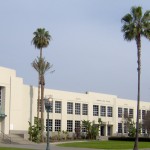A HISTORY OF ANAHEIM HIGH SCHOOL
Pride of the Colony – Built on Tradition
Anaheim High School, first established in 1898, is the oldest of nine comprehensive high schools in the Anaheim Union High School District. It is the third oldest high school in Orange County, behind Santa Ana (1889) and Fullerton (1893).
Following is a timeline of the formation of Anaheim High, from its humble beginnings in an crude adobe structure to its current state, an impressive art deco building dedicated in 1936.
ANAHEIM HIGH SCHOOL TIMELINE
1859 – Soon after the first German colonists arrive, they petition the Los Angeles County superintendent of schools to establish a school in Anaheim, their new home by the Santa Ana River.
1860 – Anaheim’s first school opens in an adobe building located on a lot owned by August Langenberger, a prominent merchant and colony leader. The first teacher is F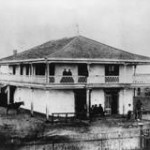 red William Kuelp. His initial nine students are: Carola, Regina and Fred Langenberger; Elmina and Louise Lorenz; Pifanio and Antonio Burruel; and Tomas and Felipe Yorba.
red William Kuelp. His initial nine students are: Carola, Regina and Fred Langenberger; Elmina and Louise Lorenz; Pifanio and Antonio Burruel; and Tomas and Felipe Yorba.
1862 – One hundred dollars, paid in pure gold, purchases one of Anaheim’s original city lots for a new adobe school house. The new school is destroyed shortly thereafter by flood. Classes are moved to the second story of the Langenberger building and moved again later back to the adobe where classes were first held. This building is also occupied by the Anaheim Water Co. and a third room of this building served as the town jail. The school master was also the town’s notary public and justice of the peace.
1867 – Anaheim School District is formed.
1869 – Anaheim’s first teacher Fred William Kuelp re signs due to ill health. He is replaced by Carl Van Gulpen, who is replaced shortly thereafter by James Miller Guinn, a Civil War Veteran dubbed “The Father of Anaheim Education.”
signs due to ill health. He is replaced by Carl Van Gulpen, who is replaced shortly thereafter by James Miller Guinn, a Civil War Veteran dubbed “The Father of Anaheim Education.”
1870 – The first monthly report of Anaheim students lists an enrollment of 91 students, divided into two departments (Primary and Grammar) and taught by two teachers. The town’s population at this time is estimated at 1,000.
1871 – The first school exhibit is staged with a program of declamations, dialogues, farces, tableaux and music. By charging a fee for this first open house, Guinn is able to purchase charts and an outline map for the school. Guinn also establishes the first final examination dates, which included an oral exam that was open to the public.
1874 – Guinn, a graduate of Oberlin College in Ohio, serves as teacher and prin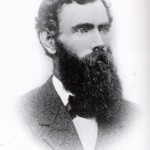 cipal, offering subjects for high school diploma and classifies students into grades. His 20 pupils attend school in an adobe building with one window, empty boxes and benches for seats and crudely constructed tables for desks.
cipal, offering subjects for high school diploma and classifies students into grades. His 20 pupils attend school in an adobe building with one window, empty boxes and benches for seats and crudely constructed tables for desks.
1877 – A plot of land is purchased for a new school building at the cost of $1,500.
1878 – Guinn writes and champions a bond to construct a new school building, raising $10,000. When the bill is passed by the legislature on March 12, 1878, it marks the first time ever in California that a school district uses a bond issue to finance new school facilities.
1879 – The new two-story Central School, called the “handsomest school building  in the country outside of Los Angeles,” opens on January 16. The school, which features as clock steeple and bell tower, is built in the center of a two-acre lot at 231 Chartres Street. The 217 elementary through high school students are taught by two men and two women who are paid $75 a month.
in the country outside of Los Angeles,” opens on January 16. The school, which features as clock steeple and bell tower, is built in the center of a two-acre lot at 231 Chartres Street. The 217 elementary through high school students are taught by two men and two women who are paid $75 a month.
1880 – Matilda Rimpau, daughter of Anaheim pioneer Theodore 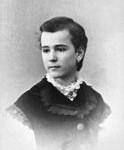 Rimpau, is the first student in the Anaheim school system to graduate with a high school diploma.
Rimpau, is the first student in the Anaheim school system to graduate with a high school diploma.
1881 – Guinn resigns his position as teacher and principal to become Los Angeles Superintendent of Schools. From the time of his resignation through 1898, there are no high school classes taught in Anaheim.
1898 – High school classes officially begin on the second floor of Central School after C.P. Evans, principal of Loara Elementary School, convinces the school board that classes should extend past the ninth year. Evans becomes principal and, assisted by Miss Helen French, teach a student body of 39 student, 17 boys and 22 girls in grades nine through twelve.
1900 – Football begins with the first recorded game played against Fullerton at Anaheim on Nov. 6. Anaheim wins 2-0.
 1901 – When Central School becomes overcrowded, citizens fund a $12,500 bond measure to buy land, build a separate high school building and equip it. Anaheim’s first high school, an imposing brick structure, is constructed on south side of Lincoln (then Center), between Harbor and Citron. Its first seven graduates are: Edith Bannerman, Alma Mills, Dora Snyder, John Dauser, Bernard Snyder, Bowman Merritt and Welborn Wallop.
1901 – When Central School becomes overcrowded, citizens fund a $12,500 bond measure to buy land, build a separate high school building and equip it. Anaheim’s first high school, an imposing brick structure, is constructed on south side of Lincoln (then Center), between Harbor and Citron. Its first seven graduates are: Edith Bannerman, Alma Mills, Dora Snyder, John Dauser, Bernard Snyder, Bowman Merritt and Welborn Wallop.
1902 – The high school’s first literary effort, The Stentorian, is publish ed in February and sold for 50 cents per year. The first issue shows a photo of the faculty and the graduating class of 1902: Arthur G. Baker, Carl Zeus, Olga Boege and Ruth D. EnReal. The first meeting of the Anaheim High Girl’s Athletic Association is held on Oct. 5.
ed in February and sold for 50 cents per year. The first issue shows a photo of the faculty and the graduating class of 1902: Arthur G. Baker, Carl Zeus, Olga Boege and Ruth D. EnReal. The first meeting of the Anaheim High Girl’s Athletic Association is held on Oct. 5.
1908 – Citizens unite to form Anaheim Union High School District. AUHSD becomes the largest union school district in California, covering 46 square miles. Students feed into Anaheim junior highs from Anaheim, Cypress, La Palma, Stanton, Los Alamitos, Rossmoor and portions of Garden Grove, Orange, Fullerton and Buena Park.
1910 – Voters approve $105,000 bond to purchase 11 acres at the northeast corner of Lincoln (then Center) and Citron, just a half block from existing school site.
1911 – The current high school at 608 W. Center (now Lincoln) is sold to the elementary school district for $25,000. The building is demolished in 1937 to make way for the construction of Fremont Junior High, which was closed in 1979 and demolished in 1980.
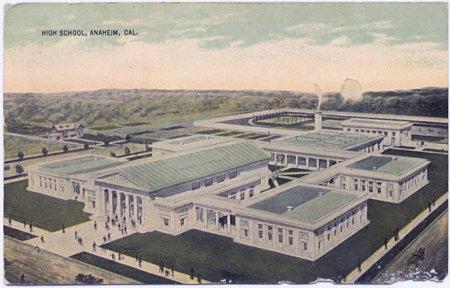 1912 – New Greek-revival Anaheim Union High School is dedicated and graduates its first class of 17 students. By the following year, almost 200 had earned a high school diploma from the school’s combined campuses.
1912 – New Greek-revival Anaheim Union High School is dedicated and graduates its first class of 17 students. By the following year, almost 200 had earned a high school diploma from the school’s combined campuses.
1918 – Class of 1918 becomes the first to wear caps and gowns at graduation.
1920s – Music education begins with teacher Joshua Williams giving free lessons in an effort to assemble a complete orchestra. He continued this practice over three decades.
1924 – First high school swimming pool in Orange County opens.
1933 – Long Beach earthquake irreparably damages AUHS, requiring i ts demolition.
ts demolition.
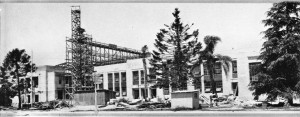 1936 – A new art deco AUHS main building, library and auditorium are dedicated. Construction is part of a Work Projects Administration (WPA) project #8291.
1936 – A new art deco AUHS main building, library and auditorium are dedicated. Construction is part of a Work Projects Administration (WPA) project #8291.
1937 – A sunken garden and fountain in school’s central patio is created.
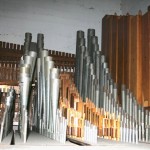 1940 – Robert Morton theater organ installed in Cook Auditorium and new swimming pool replaces its 1924 predecessor.
1940 – Robert Morton theater organ installed in Cook Auditorium and new swimming pool replaces its 1924 predecessor.
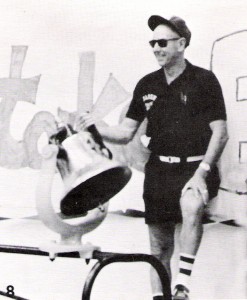 1950 – Beginning of the coach Clare Van Hoorebeke’s legendary football era, which endured through 1972.
1950 – Beginning of the coach Clare Van Hoorebeke’s legendary football era, which endured through 1972.
1953 – Anaheim High’s first drill team is formed and is coached by Helen Gruenfelder.
1957 – Western High School opens, ending Anaheim’s reign as the city’s only high school.
1960 – School district returns Anaheim High to its original name, dropping Union from its title. New buildings are constructed during this time, replacing the remaining pre-earthquake coded buildings.
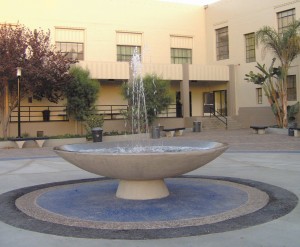 1964 – New “cereal bowl” fountain replaces sunken garden.
1964 – New “cereal bowl” fountain replaces sunken garden.
1972 – The Art Quad and other buildings are constructed to replace old barracks that had been “temporary” quarters for 15 years.
1977 – “Wimpy’s Stand,” a popular student landmark for several decades, is changed into the Student Activities Office. The building was taken down in 2007.
 2008 – Two new buildings with 49 state-of-the-art classrooms open. Classes begin February 2009.
2008 – Two new buildings with 49 state-of-the-art classrooms open. Classes begin February 2009.
Photos: Courtesy of Anaheim Public Library & the AHSAA
References:
“One To Twenty-Eight – A History of Anaheim Union High School District” by Louise Booth
“Anaheim” by Elizabeth J. Schultz and Stephen J. Faessel, a chapter in “A Hundred Years of Yesterdays,” published by the Orange County Historical Commission.
“Anaheim Colonists Football – A Century of Tradition” by Dennis Bateman
Other sources: “Anaheim High (Central School)” by Brad Pettigrew
